1 June 2023
Weekly Market View
Disjointed markets
Financial markets appear to be getting disconnected from fundamentals. Parts of the equity market are in the grips of a frenzy seen during the dot-com bubble on the hope that Generative Artificial Intelligence (AI) is about to transform the world sooner than many expect.
Meanwhile, underlying fundamentals in Europe are deteriorating, while China’s post-pandemic burst of activity is fading. The agreement to suspend the US debt ceiling is unlikely to be a panacea either, as it entails spending caps until 2025, and a near-term drainage of market liquidity as the Treasury borrows to replenish cash.
Amid this noise, we believe it would be prudent for investors to go back to the basics: ensure they have a sound foundational allocation commensurate with their risk appetite.
In this report, we examine some of the latest debates and provide a few medium-term opportunities arising from the dislocation in markets.
Is the US technology sector rally sustainable?
What could trigger a recovery in China stocks?
Is it time to add exposure to the Japanese yen?
Charts of the week: Narrow breadth
The US equity market has been driven by select technology sector stocks; this has resulted in disparate valuations
S&P500, S&P500 equal-weighted, S&P500 tech sector indices
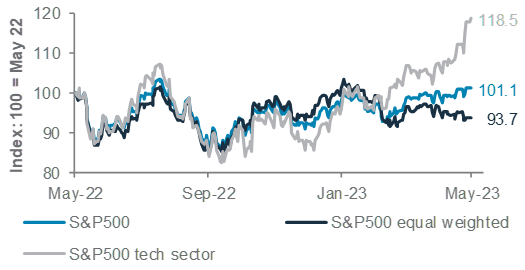
2023 forward P/E ratio of US equity sectors today vs 1 Jan ’23
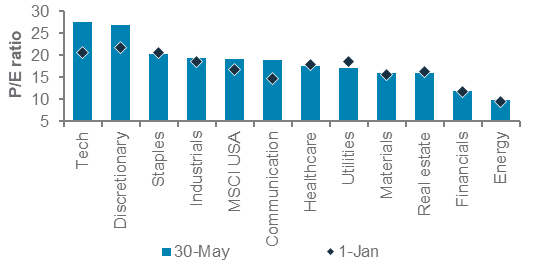
Source: Bloomberg, Standard Chartered
Editorial
Disjointed markets
Financial markets appear to be getting disconnected from fundamentals. Parts of the equity market are in the grips of a frenzy seen during the dot-com bubble on the hope that Generative Artificial Intelligence (AI) is about to transform the world sooner than many expect. Meanwhile, underlying fundamentals in Europe are deteriorating, while China’s post-pandemic burst of activity is fading. Amid this noise, we believe it would be prudent for investors to go back to the basics: ensure they have a sound foundational allocation commensurate with their risk appetite. Here we examine some of the latest debates and provide a few medium-term opportunities arising from the dislocation in markets.
AI – wave or bubble? Prudence dictates not chasing the AI-driven frenzy in technology stocks. We remain Neutral on the sector in the US, Europe and China, which helps us participate in the rally without actively chasing it. Valuations in the AI subsector have reached the bubble territory comparable to dot-com days. The hope is that AI will turbo-charge productivity, but that could take years, not months, as markets seem to be pricing. Before that, we have a likely US recession to overcome.
US debt-ceiling breakthrough unlikely to be panacea: Be careful about what you wish for! While the US Congress looks likely to pass a bill to suspend the debt ceiling until 2025, after the US Presidential election, it entails capping federal spending for the next two years. The non-partisan Congressional Budget Office estimates USD64bn of spending cuts next year alone. The spending cap also means that the government’s hands would be tied in the event the US enters a recession later this year, as we expect. Also, the US Treasury is likely to borrow big once the debt ceiling is raised. This is likely to suck liquidity out of markets at a time when risk assets face headwinds from a global growth slowdown. In that event, the Fed could end its Quantitative Tightening policy early, easing some of the liquidity crunch, but perhaps not enough to sustain the AI-driven rally.
Another Fed rate hike? Since March, markets have unwound bets of three Fed rate cuts by the end of the year and are now pricing in a non-negligible chance of a rate hike in June instead. Expectations of a debt ceiling deal, easing concerns about an imminent banking crisis, resilient consumption, better-than-expected Q1 earnings and elevated inflation have contributed to this Fed repricing. Strong US job market and inflation data for May would raise the chance of another Fed rate hike in June or July. However, global economic activity, mainly in manufacturing and trade, continues to slow. This is reflected in the slump in crude oil and copper prices. Euro area and China data have underwhelmed lately, adding to concerns. Germany has already entered a technical recession. Our base case is for a rate pause and a US recession starting in Q4. This is likely to crimp corporate earnings, dragging equity markets.
Investment implications: We see limited upside to stocks following the lifting of the US debt ceiling, given ensuing spending cap, liquidity crunch and further deterioration in global economic activity. We would use the latest rally in equities to rotate to more defensive assets, especially Developed Market investment grade government bonds, where yields are now more attractive than a month ago, and predominantly Investment Grade Asia USD-denominated bonds. Those excessively exposed to technology sector equities after the latest rally should consider rotating into more defensive sectors.
We recently upgraded Japan’s stocks due to cheap valuations, improving corporate governance and likely earnings upside for exporters from an undervalued JPY. We believe those with a 6-12-month horizon have an opportunity to add exposure to the JPY (we see at least 10% upside in JPY vs USD over the next 12 months) and park some of it in Japanese equities.
Gold remains a buy below USD 1950/oz as long-term US real rates and USD are likely near their peak. Geopolitical risks and global central bank buying continue to provide support for gold.
— Rajat Bhattacharya
The weekly macro balance sheet
Our weekly net assessment: On balance, we see the past week’s data and policy as neutral for risk assets in the near term
(+) factor: US debt ceiling deal, easing Euro area inflation expectations
(-) factor: Sticky US inflation, weaker US consumer confidence, Euro area economic confidence, weaker-than-expected China PMIs
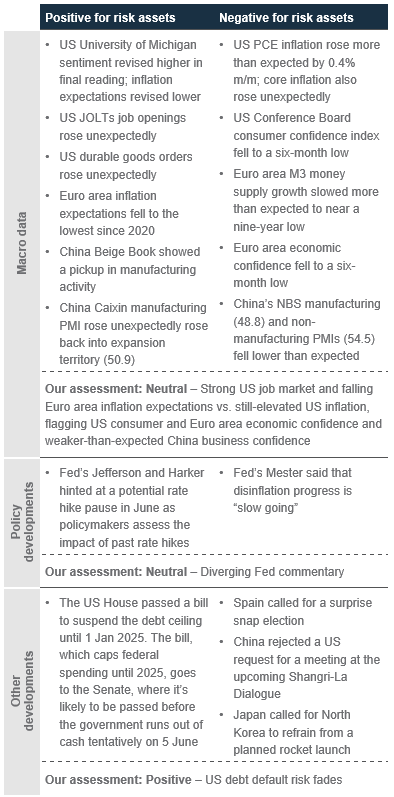
Markets have pared back expectations of Fed rate cuts and are now pricing in a non-negligible chance of another rate hike in June or July instead
Money market expectations of Fed rate hike, today vs. mid-March
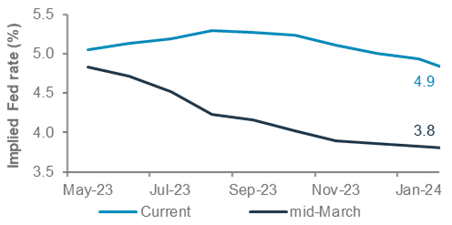
Euro area economic confidence has weakened as rate hikes start to tighten financial conditions
Euro area economic confidence; M1 and M3 money supply
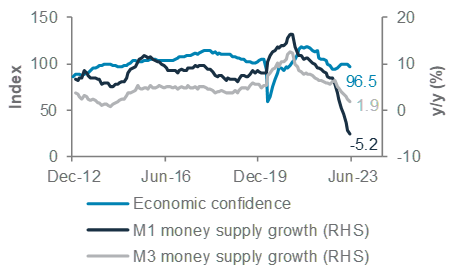
China’s business confidence in May fell below expectations, with the manufacturing sector particularly hit by slowing global demand
China NBS manufacturing and non-manufacturing PMI
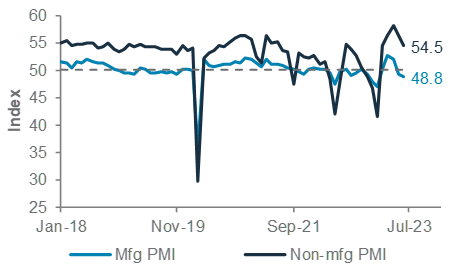
Top client questions
Is the US technology sector equity rally sustainable?
The US technology sector has been the best-performing sector YTD, with c. 35% gain. In Q1, the sector was driven by resilient growth data, lower bond yields (supporting higher valuations) and corporate cost-control measures. In Q2, excitement about a demand boost from AI applications is driving the sector, especially the semiconductor sub-sector. Although we are positive on the structural opportunity presented by AI, our short-term market diversity indicator is signalling stretched conditions for the semiconductor sub-sector (SOX index), raising the odds of a consolidation or a reversal. Technically, the technology sector-heavy Nasdaq 100 index is close to a key resistance level (14,500). Several major stocks in Nasdaq have made highs but subsequently saw pullbacks with high volume, typically a sign of a broader short-term pullback. Valuation of the technology sector has also expanded significantly, with the consensus 2023 forward P/E rising from 21x in January to 28x.
We have a Neutral view on the US technology sector, expecting it to perform in line with the broader market over the next 6-12 months. Investors should consider rotating into our preferred healthcare and consumer staples sectors, which are more defensive ahead of an expected US recession later this year. We are Overweight the communication services sector given its strong earnings momentum, but technical indicators are also stretched in the near term.
— Fook Hien Yap, Senior Investment Strategist
What could trigger a recovery in China stocks?
China stocks have entered a bear market after hitting a peak in January following the lifting of the pandemic restrictions late last year. The brief recovery after the National People’s Congress in March has faded. The weakness can be ascribed to the following:
- Sluggish economic recovery – China’s economic data has disappointed expectations lately. This week’s below-expectation manufacturing and non-manufacturing PMI added to concerns.
- Geopolitical tensions – China’s decision to ban Micron memory chips after the US slapped restrictions on some hi-tech semiconductor-related exports to China has escalated tensions.
We believe the easiest part of China’s post-pandemic recovery is likely behind us. Hence, we recently downgraded China equities to Neutral from Overweight within our Asia ex-Japan equity allocation. While the gradual recovery in domestic consumption is likely to sustain growth this year, slowing global demand is likely to add to disinflationary pressures. Hence, the next leg of China’s equity market gains will likely need further policy stimulus. While authorities have already enacted several stimulus measures (see table), we see scope for additional policy easing, especially if the economy deteriorates. Meanwhile, we anticipate more inflows into Asian equity markets, including to Japan, in the coming months as US and European equity markets trend lower due to rising recession risks.
— Zhong Liang Han, CFA, Investment Strategist
The technology sector-heavy Nasdaq 100 index has performed strongly this year, and is testing key resistance at 14,500
Nasdaq 100 index (NDX)
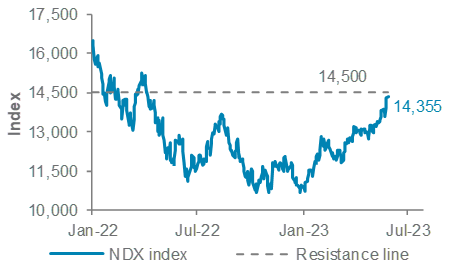
China authorities have already enacted several stimulus measures
Stimulus measures since the ‘Two Sessions’ in March
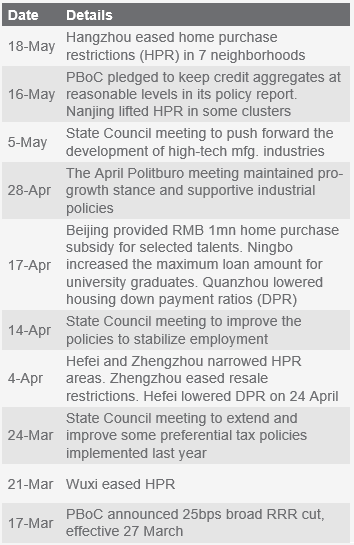
Top client questions (cont’d)
Is it time to add exposure to the JPY?
We believe that the recent bout of JPY weakness is an opportunity for investors to add exposure to the currency at attractive levels. The rise in USD/JPY (or the JPY weakness) since mid-March 2023 has been driven by a combination of a rise in US government bond yields and markets pricing out the likelihood of a shift towards a tighter BoJ monetary policy.
However, we think that the market reaction is now looking overdone. Our Global Investment Committee expects 10-year US government bond yields to decline below 3.5% over the next three months and eventually fall below 3% in H1 2024 as the Fed starts cutting rates in Q4. This should drive interest rate differentials between the US and Japan lower, pushing USD/JPY lower (or the JPY stronger).
We also believe the pressure on the BoJ to ultimately scrap its extremely dovish Yield Curve Control (YCC) policy and take Japan’s benchmark interest rates back to positive territory remains in place. This week, Japanese officials had an unscheduled meeting and currency official Masato Kanda stated that the government would provide “appropriate response” to the JPY weakness, if necessary. The comments raise the risk of a government intervention to prevent excessive weakening of the JPY.
From a technical perspective, we see 142.35 as the near-term resistance for USD/JPY, with 137.25 being the immediate support. We expect USD/JPY to decline towards 134-135 over the next three months.
— Abhilash Narayan, Senior Investment Strategist
We expect the USD/JPY to decline towards 134-135 over the next three months
USD/JPY
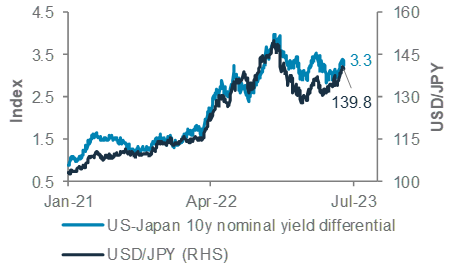
What is the likely impact on bond markets following any US debt ceiling resolution and from another Fed rate hike?
We expect a US debt ceiling deal and another Fed rate hike to both drive US government bond yields lower over the next 6-12 months. The debt ceiling deal involves a cap on spending, making it disinflationary and growth negative. Increased recession risk is likely to lead to greater demand for long-dated government bonds, driving bond yields lower. While an increase in government bond supply should technically drive yields higher, we believe the impact on the 10-year yield is likely to be limited as the supply pressure is largely confined to the short-maturity T-bills. Meanwhile, another Fed rate hike in June/July, would result in further monetary tightening, further subduing growth. Also, as we edge closer to the end of a rate hike cycle, US government bond yields tend to drop historically.
We expect the 10-year US government bond yield to range between 2.75-3.00% over the next 6-12 months. Against this backdrop, we Overweight DM IG government bonds. We are Neutral DM IG corporate bonds. While they should benefit from lower government bond yields, given their higher interest rate sensitivity, relatively expensive yield premiums temper our optimism. Although the recent corporate earnings were supportive, the business environment is likely to grow more challenging, raising recession risks.
— Cedric Lam, Senior Investment Strategist
The yield premium on Developed Market (DM) Investment Grade (IG) corporate bonds is low relative to history
DM IG corporate bond spread
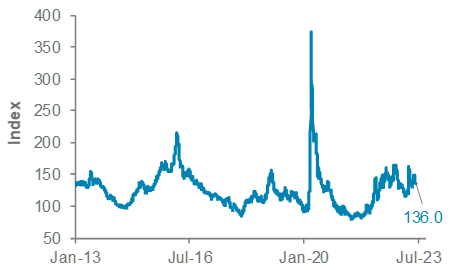
Market performance summary*
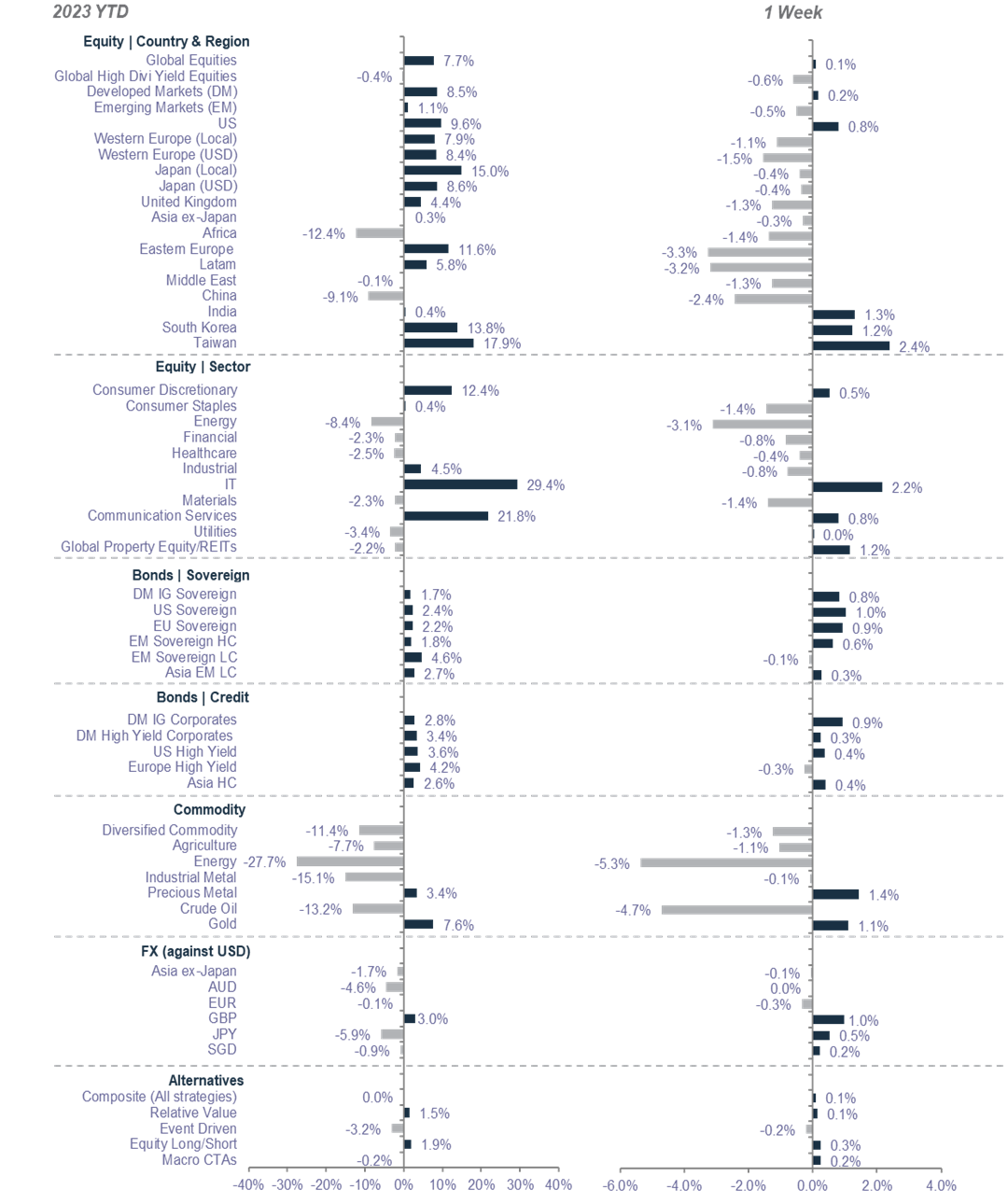
*Performance in USD terms unless otherwise stated, 2023 YTD performance from 31 December 2022 to 31 May 2023; 1-week period: 24 May 2023 to 31 May 2023
Our 12-month asset class views at a glance
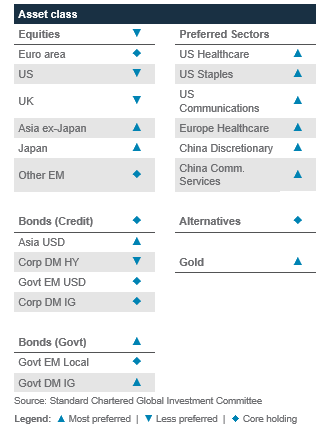
Economic and market calendar
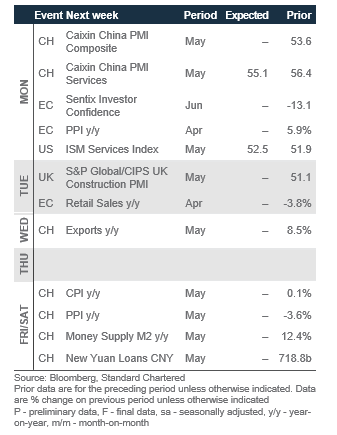
The US S&P500 index is close to a major resistance
Technical indicators for key markets as of 31 May close
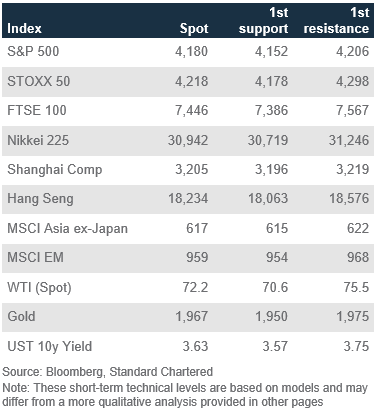
Investor diversity remains healthy across asset classes
Our proprietary market diversity indicators as of 31 May
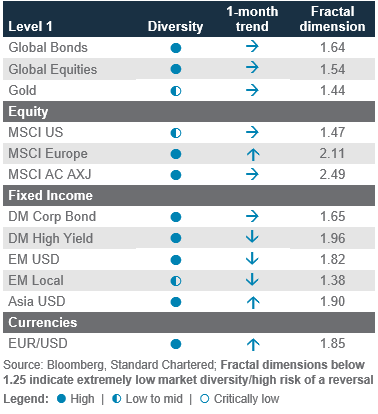
Disclosure
This document is confidential and may also be privileged. If you are not the intended recipient, please destroy all copies and notify the sender immediately. This document is being distributed for general information only and is subject to the relevant disclaimers available at our Standard Chartered website under Regulatory disclosures. It is not and does not constitute research material, independent research, an offer, recommendation or solicitation to enter into any transaction or adopt any hedging, trading or investment strategy, in relation to any securities or other financial instruments. This document is for general evaluation only. It does not take into account the specific investment objectives, financial situation or particular needs of any particular person or class of persons and it has not been prepared for any particular person or class of persons. You should not rely on any contents of this document in making any investment decisions. Before making any investment, you should carefully read the relevant offering documents and seek independent legal, tax and regulatory advice. In particular, we recommend you to seek advice regarding the suitability of the investment product, taking into account your specific investment objectives, financial situation or particular needs, before you make a commitment to purchase the investment product. Opinions, projections and estimates are solely those of SC at the date of this document and subject to change without notice. Past performance is not indicative of future results and no representation or warranty is made regarding future performance. The value of investments, and the income from them, can go down as well as up, and you may not recover the amount of your original investment. You are not certain to make a profit and may lose money. Any forecast contained herein as to likely future movements in rates or prices or likely future events or occurrences constitutes an opinion only and is not indicative of actual future movements in rates or prices or actual future events or occurrences (as the case may be). This document must not be forwarded or otherwise made available to any other person without the express written consent of the Standard Chartered Group (as defined below). Standard Chartered Bank is incorporated in England with limited liability by Royal Charter 1853 Reference Number ZC18. The Principal Office of the Company is situated in England at 1 Basinghall Avenue, London, EC2V 5DD. Standard Chartered Bank is authorised by the Prudential Regulation Authority and regulated by the Financial Conduct Authority and Prudential Regulation Authority. Standard Chartered PLC, the ultimate parent company of Standard Chartered Bank, together with its subsidiaries and affiliates (including each branch or representative office), form the Standard Chartered Group. Standard Chartered Private Bank is the private banking division of Standard Chartered. Private banking activities may be carried out internationally by different legal entities and affiliates within the Standard Chartered Group (each an “SC Group Entity”) according to local regulatory requirements. Not all products and services are provided by all branches, subsidiaries and affiliates within the Standard Chartered Group. Some of the SC Group Entities only act as representatives of Standard Chartered Private Bank and may not be able to offer products and services or offer advice to clients.
Copyright © 2025, Accounting Research & Analytics, LLC d/b/a CFRA (and its affiliates, as applicable). Reproduction of content provided by CFRA in any form is prohibited except with the prior written permission of CFRA. CFRA content is not investment advice and a reference to or observation concerning a security or investment provided in the CFRA SERVICES is not a recommendation to buy, sell or hold such investment or security or make any other investment decisions. The CFRA content contains opinions of CFRA based upon publicly-available information that CFRA believes to be reliable and the opinions are subject to change without notice. This analysis has not been submitted to, nor received approval from, the United States Securities and Exchange Commission or any other regulatory body. While CFRA exercised due care in compiling this analysis, CFRA, ITS THIRD-PARTY SUPPLIERS, AND ALL RELATED ENTITIES SPECIFICALLY DISCLAIM ALL WARRANTIES, EXPRESS OR IMPLIED, INCLUDING, BUT NOT LIMITED TO, ANY WARRANTIES OF MERCHANTABILITY OR FITNESS FOR A PARTICULAR PURPOSE OR USE, to the full extent permitted by law, regarding the accuracy, completeness, or usefulness of this information and assumes no liability with respect to the consequences of relying on this information for investment or other purposes. No content provided by CFRA (including ratings, credit-related analyses and data, valuations, model, software or other application or output therefrom) or any part thereof may be modified, reverse engineered, reproduced or distributed in any form by any means, or stored in a database or retrieval system, without the prior written permission of CFRA, and such content shall not be used for any unlawful or unauthorized purposes. CFRA and any third-party providers, as well as their directors, officers, shareholders, employees or agents do not guarantee the accuracy, completeness, timeliness or availability of such content. In no event shall CFRA, its affiliates, or their third-party suppliers be liable for any direct, indirect, special, or consequential damages, costs, expenses, legal fees, or losses (including lost income or lost profit and opportunity costs) in connection with a subscriber’s, subscriber’s customer’s, or other’s use of CFRA’s content.
Market Abuse Regulation (MAR) Disclaimer
Banking activities may be carried out internationally by different branches, subsidiaries and affiliates within the Standard Chartered Group according to local regulatory requirements. Opinions may contain outright “buy”, “sell”, “hold” or other opinions. The time horizon of this opinion is dependent on prevailing market conditions and there is no planned frequency for updates to the opinion. This opinion is not independent of Standard Chartered Group’s trading strategies or positions. Standard Chartered Group and/or its affiliates or its respective officers, directors, employee benefit programmes or employees, including persons involved in the preparation or issuance of this document may at any time, to the extent permitted by applicable law and/or regulation, be long or short any securities or financial instruments referred to in this document or have material interest in any such securities or related investments. Therefore, it is possible, and you should assume, that Standard Chartered Group has a material interest in one or more of the financial instruments mentioned herein. Please refer to our Standard Chartered website under Regulatory disclosures for more detailed disclosures, including past opinions/ recommendations in the last 12 months and conflict of interests, as well as disclaimers. A covering strategist may have a financial interest in the debt or equity securities of this company/issuer. All covering strategist are licensed to provide investment recommendations under Monetary Authority of Singapore or Hong Kong Monetary Authority. This document must not be forwarded or otherwise made available to any other person without the express written consent of Standard Chartered Group.
Sustainable Investments
Any ESG data used or referred to has been provided by Morningstar, Sustainalytics, MSCI or Bloomberg. Refer to 1) Morningstar website under Sustainable Investing, 2) Sustainalytics website under ESG Risk Ratings, 3) MCSI website under ESG Business Involvement Screening Research and 4) Bloomberg green, social & sustainability bonds guide for more information. The ESG data is as at the date of publication based on data provided, is for informational purpose only and is not warranted to be complete, timely, accurate or suitable for a particular purpose, and it may be subject to change. Sustainable Investments (SI): This refers to funds that have been classified as ‘Sustainable Investments’ by Morningstar. SI funds have explicitly stated in their prospectus and regulatory filings that they either incorporate ESG factors into the investment process or have a thematic focus on the environment, gender diversity, low carbon, renewable energy, water or community development. For equity, it refers to shares/stocks issued by companies with Sustainalytics ESG Risk Rating of Low/Negligible. For bonds, it refers to debt instruments issued by issuers with Sustainalytics ESG Risk Rating of Low/Negligible, and/or those being certified green, social, sustainable bonds by Bloomberg. For structured products, it refers to products that are issued by any issuer who has a Sustainable Finance framework that aligns with Standard Chartered’s Green and Sustainable Product Framework, with underlying assets that are part of the Sustainable Investment universe or separately approved by Standard Chartered’s Sustainable Finance Governance Committee. Sustainalytics ESG risk ratings shown are factual and are not an indicator that the product is classified or marketed as “green”, “sustainable” or similar under any particular classification system or framework.
Country/Market Specific Disclosures
Botswana: This document is being distributed in Botswana by, and is attributable to, Standard Chartered Bank Botswana Limited which is a financial institution licensed under the Section 6 of the Banking Act CAP 46.04 and is listed in the Botswana Stock Exchange. Brunei Darussalam: This document is being distributed in Brunei Darussalam by, and is attributable to, Standard Chartered Bank (Brunei Branch) | Registration Number RFC/61 and Standard Chartered Securities (B) Sdn Bhd | Registration Number RC20001003. Standard Chartered Bank is incorporated in England with limited liability by Royal Charter 1853 Reference Number ZC18. Standard Chartered Securities (B) Sdn Bhd is a limited liability company registered with the Registry of Companies with Registration Number RC20001003 and licensed by Brunei Darussalam Central Bank as a Capital Markets Service License Holder with License Number BDCB/R/CMU/S3-CL and it is authorised to conduct Islamic investment business through an Islamic window. China Mainland: This document is being distributed in China by, and is attributable to, Standard Chartered Bank (China) Limited which is mainly regulated by National Financial Regulatory Administration (NFRA), State Administration of Foreign Exchange (SAFE), and People’s Bank of China (PBOC). Hong Kong: In Hong Kong, this document, except for any portion advising on or facilitating any decision on futures contracts trading, is distributed by Standard Chartered Bank (Hong Kong) Limited (“SCBHK”), a subsidiary of Standard Chartered PLC. SCBHK has its registered address at 32/F, Standard Chartered Bank Building, 4-4A Des Voeux Road Central, Hong Kong and is regulated by the Hong Kong Monetary Authority and registered with the Securities and Futures Commission (“SFC”) to carry on Type 1 (dealing in securities), Type 4 (advising on securities), Type 6 (advising on corporate finance) and Type 9 (asset management) regulated activity under the Securities and Futures Ordinance (Cap. 571) (“SFO”) (CE No. AJI614). The contents of this document have not been reviewed by any regulatory authority in Hong Kong and you are advised to exercise caution in relation to any offer set out herein. If you are in doubt about any of the contents of this document, you should obtain independent professional advice. Any product named herein may not be offered or sold in Hong Kong by means of any document at any time other than to “professional investors” as defined in the SFO and any rules made under that ordinance. In addition, this document may not be issued or possessed for the purposes of issue, whether in Hong Kong or elsewhere, and any interests may not be disposed of, to any person unless such person is outside Hong Kong or is a “professional investor” as defined in the SFO and any rules made under that ordinance, or as otherwise may be permitted by that ordinance. In Hong Kong, Standard Chartered Private Bank is the private banking division of SCBHK, a subsidiary of Standard Chartered PLC. Ghana: Standard Chartered Bank Ghana Limited accepts no liability and will not be liable for any loss or damage arising directly or indirectly (including special, incidental or consequential loss or damage) from your use of these documents. Past performance is not indicative of future results and no representation or warranty is made regarding future performance. You should seek advice from a financial adviser on the suitability of an investment for you, taking into account these factors before making a commitment to invest in an investment. To unsubscribe from receiving further updates, please send an email to feedback.ghana@sc.com. Please do not reply to this email. Call our Priority Banking on 0302610750 for any questions or service queries. You are advised not to send any confidential and/or important information to Standard Chartered via e-mail, as Standard Chartered makes no representations or warranties as to the security or accuracy of any information transmitted via e-mail. Standard Chartered shall not be responsible for any loss or damage suffered by you arising from your decision to use e-mail to communicate with the Bank. India: This document is being distributed in India by Standard Chartered in its capacity as a distributor of mutual funds and referrer of any other third party financial products. Standard Chartered does not offer any ‘Investment Advice’ as defined in the Securities and Exchange Board of India (Investment Advisers) Regulations, 2013 or otherwise. Services/products related securities business offered by Standard Charted are not intended for any person, who is a resident of any jurisdiction, the laws of which imposes prohibition on soliciting the securities business in that jurisdiction without going through the registration requirements and/or prohibit the use of any information contained in this document. Indonesia: This document is being distributed in Indonesia by Standard Chartered Bank, Indonesia branch, which is a financial institution licensed and supervised by Otoritas Jasa Keuangan (Financial Service Authority) and Bank Indonesia. Jersey: In Jersey, Standard Chartered Private Bank is the Registered Business Name of the Jersey Branch of Standard Chartered Bank. The Jersey Branch of Standard Chartered Bank is regulated by the Jersey Financial Services Commission. Copies of the latest audited accounts of Standard Chartered Bank are available from its principal place of business in Jersey: PO Box 80, 15 Castle Street, St Helier, Jersey JE4 8PT. Standard Chartered Bank is incorporated in England with limited liability by Royal Charter in 1853 Reference Number ZC 18. The Principal Office of the Company is situated in England at 1 Basinghall Avenue, London, EC2V 5DD. Standard Chartered Bank is authorised by the Prudential Regulation Authority and regulated by the Financial Conduct Authority and Prudential Regulation Authority. The Jersey Branch of Standard Chartered Bank is also an authorised financial services provider under license number 44946 issued by the Financial Sector Conduct Authority of the Republic of South Africa. Jersey is not part of the United Kingdom and all business transacted with Standard Chartered Bank, Jersey Branch and other SC Group Entity outside of the United Kingdom, are not subject to some or any of the investor protection and compensation schemes available under United Kingdom law. Kenya: This document is being distributed in Kenya by and is attributable to Standard Chartered Bank Kenya Limited. Investment Products and Services are distributed by Standard Chartered Investment Services Limited, a wholly owned subsidiary of Standard Chartered Bank Kenya Limited that is licensed by the Capital Markets Authority in Kenya, as a Fund Manager. Standard Chartered Bank Kenya Limited is regulated by the Central Bank of Kenya. Malaysia: This document is being distributed in Malaysia by Standard Chartered Bank Malaysia Berhad (“SCBMB”). Recipients in Malaysia should contact SCBMB in relation to any matters arising from, or in connection with, this document. This document has not been reviewed by the Securities Commission Malaysia. The product lodgement, registration, submission or approval by the Securities Commission of Malaysia does not amount to nor indicate recommendation or endorsement of the product, service or promotional activity. Investment products are not deposits and are not obligations of, not guaranteed by, and not protected by SCBMB or any of the affiliates or subsidiaries, or by Perbadanan Insurans Deposit Malaysia, any government or insurance agency. Investment products are subject to investment risks, including the possible loss of the principal amount invested. SCBMB expressly disclaim any liability and responsibility for any loss arising directly or indirectly (including special, incidental or consequential loss or damage) arising from the financial losses of the Investment Products due to market condition. Nigeria: This document is being distributed in Nigeria by Standard Chartered Bank Nigeria Limited (SCB Nigeria), a bank duly licensed and regulated by the Central Bank of Nigeria. SCB Nigeria accepts no liability for any loss or damage arising directly or indirectly (including special, incidental or consequential loss or damage) from your use of these documents. You should seek advice from a financial adviser on the suitability of an investment for you, taking into account these factors before making a commitment to invest in an investment. To unsubscribe from receiving further updates, please send an email to clientcare.ng@sc.com requesting to be removed from our mailing list. Please do not reply to this email. Call our Priority Banking on 02 012772514 for any questions or service queries. SCB Nigeria shall not be responsible for any loss or damage arising from your decision to send confidential and/or important information to Standard Chartered via e-mail. SCB Nigeria makes no representations or warranties as to the security or accuracy of any information transmitted via e-mail. Pakistan: This document is being distributed in Pakistan by, and attributable to Standard Chartered Bank (Pakistan) Limited having its registered office at PO Box 5556, I.I Chundrigar Road Karachi, which is a banking company registered with State Bank of Pakistan under Banking Companies Ordinance 1962 and is also having licensed issued by Securities & Exchange Commission of Pakistan for Security Advisors. Standard Chartered Bank (Pakistan) Limited acts as a distributor of mutual funds and referrer of other third-party financial products. Singapore: This document is being distributed in Singapore by, and is attributable to, Standard Chartered Bank (Singapore) Limited (Registration No. 201224747C/ GST Group Registration No. MR-8500053-0, “SCBSL”). Recipients in Singapore should contact SCBSL in relation to any matters arising from, or in connection with, this document. SCBSL is an indirect wholly owned subsidiary of Standard Chartered Bank and is licensed to conduct banking business in Singapore under the Singapore Banking Act, 1970. Standard Chartered Private Bank is the private banking division of SCBSL. IN RELATION TO ANY SECURITY OR SECURITIES-BASED DERIVATIVES CONTRACT REFERRED TO IN THIS DOCUMENT, THIS DOCUMENT, TOGETHER WITH THE ISSUER DOCUMENTATION, SHALL BE DEEMED AN INFORMATION MEMORANDUM (AS DEFINED IN SECTION 275 OF THE SECURITIES AND FUTURES ACT, 2001 (“SFA”)). THIS DOCUMENT IS INTENDED FOR DISTRIBUTION TO ACCREDITED INVESTORS, AS DEFINED IN SECTION 4A(1)(a) OF THE SFA, OR ON THE BASIS THAT THE SECURITY OR SECURITIES-BASED DERIVATIVES CONTRACT MAY ONLY BE ACQUIRED AT A CONSIDERATION OF NOT LESS THAN S$200,000 (OR ITS EQUIVALENT IN A FOREIGN CURRENCY) FOR EACH TRANSACTION. Further, in relation to any security or securities-based derivatives contract, neither this document nor the Issuer Documentation has been registered as a prospectus with the Monetary Authority of Singapore under the SFA. Accordingly, this document and any other document or material in connection with the offer or sale, or invitation for subscription or purchase, of the product may not be circulated or distributed, nor may the product be offered or sold, or be made the subject of an invitation for subscription or purchase, whether directly or indirectly, to persons other than a relevant person pursuant to section 275(1) of the SFA, or any person pursuant to section 275(1A) of the SFA, and in accordance with the conditions specified in section 275 of the SFA, or pursuant to, and in accordance with the conditions of, any other applicable provision of the SFA. In relation to any collective investment schemes referred to in this document, this document is for general information purposes only and is not an offering document or prospectus (as defined in the SFA). This document is not, nor is it intended to be (i) an offer or solicitation of an offer to buy or sell any capital markets product; or (ii) an advertisement of an offer or intended offer of any capital markets product. Deposit Insurance Scheme: Singapore dollar deposits of non-bank depositors are insured by the Singapore Deposit Insurance Corporation, for up to S$100,000 in aggregate per depositor per Scheme member by law. Foreign currency deposits, dual currency investments, structured deposits and other investment products are not insured. This advertisement has not been reviewed by the Monetary Authority of Singapore. Taiwan: SC Group Entity or Standard Chartered Bank (Taiwan) Limited (“SCB (Taiwan)”) may be involved in the financial instruments contained herein or other related financial instruments. The author of this document may have discussed the information contained herein with other employees or agents of SC or SCB (Taiwan). The author and the above-mentioned employees of SC or SCB (Taiwan) may have taken related actions in respect of the information involved (including communication with customers of SC or SCB (Taiwan) as to the information contained herein). The opinions contained in this document may change, or differ from the opinions of employees of SC or SCB (Taiwan). SC and SCB (Taiwan) will not provide any notice of any changes to or differences between the above-mentioned opinions. This document may cover companies with which SC or SCB (Taiwan) seeks to do business at times and issuers of financial instruments. Therefore, investors should understand that the information contained herein may serve as specific purposes as a result of conflict of interests of SC or SCB (Taiwan). SC, SCB (Taiwan), the employees (including those who have discussions with the author) or customers of SC or SCB (Taiwan) may have an interest in the products, related financial instruments or related derivative financial products contained herein; invest in those products at various prices and on different market conditions; have different or conflicting interests in those products. The potential impacts include market makers’ related activities, such as dealing, investment, acting as agents, or performing financial or consulting services in relation to any of the products referred to in this document. UAE: DIFC – Standard Chartered Bank is incorporated in England with limited liability by Royal Charter 1853 Reference Number ZC18.The Principal Office of the Company is situated in England at 1 Basinghall Avenue, London, EC2V 5DD. Standard Chartered Bank is authorised by the Prudential Regulation Authority and regulated by the Financial Conduct Authority and Prudential Regulation Authority. Standard Chartered Bank, Dubai International Financial Centre having its offices at Dubai International Financial Centre, Building 1, Gate Precinct, P.O. Box 999, Dubai, UAE is a branch of Standard Chartered Bank and is regulated by the Dubai Financial Services Authority (“DFSA”). This document is intended for use only by Professional Clients and is not directed at Retail Clients as defined by the DFSA Rulebook. In the DIFC we are authorised to provide financial services only to clients who qualify as Professional Clients and Market Counterparties and not to Retail Clients. As a Professional Client you will not be given the higher retail client protection and compensation rights and if you use your right to be classified as a Retail Client we will be unable to provide financial services and products to you as we do not hold the required license to undertake such activities. For Islamic transactions, we are acting under the supervision of our Shariah Supervisory Committee. Relevant information on our Shariah Supervisory Committee is currently available on the Standard Chartered Bank website in the Islamic banking section. For residents of the UAE – Standard Chartered Bank UAE does not provide financial analysis or consultation services in or into the UAE within the meaning of UAE Securities and Commodities Authority Decision No. 48/r of 2008 concerning financial consultation and financial analysis. Uganda: Our Investment products and services are distributed by Standard Chartered Bank Uganda Limited, which is licensed by the Capital Markets Authority as an investment adviser. United Kingdom: In the UK, Standard Chartered Bank is authorised by the Prudential Regulation Authority and regulated by the Financial Conduct Authority and Prudential Regulation Authority. This communication has been approved by Standard Chartered Bank for the purposes of Section 21 (2) (b) of the United Kingdom’s Financial Services and Markets Act 2000 (“FSMA”) as amended in 2010 and 2012 only. Standard Chartered Bank (trading as Standard Chartered Private Bank) is also an authorised financial services provider (license number 45747) in terms of the South African Financial Advisory and Intermediary Services Act, 2002. The Materials have not been prepared in accordance with UK legal requirements designed to promote the independence of investment research, and that it is not subject to any prohibition on dealing ahead of the dissemination of investment research. Vietnam: This document is being distributed in Vietnam by, and is attributable to, Standard Chartered Bank (Vietnam) Limited which is mainly regulated by State Bank of Vietnam (SBV). Recipients in Vietnam should contact Standard Chartered Bank (Vietnam) Limited for any queries regarding any content of this document. Zambia: This document is distributed by Standard Chartered Bank Zambia Plc, a company incorporated in Zambia and registered as a commercial bank and licensed by the Bank of Zambia under the Banking and Financial Services Act Chapter 387 of the Laws of Zambia.
